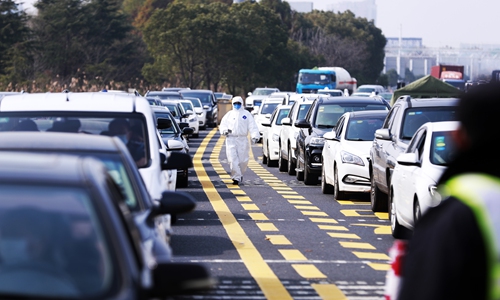HOME >> OPINION
Epidemic battle a test of control mechanism
Source:Global Times Published: 2020/2/10 22:30:14

Vehicles line up for inspection at a public security checkpoint on the Shanghai-Chongqing expressway on Sunday. The Shanghai municipal government has taken a series of measures seeking to contain the spread of the virus as people return to the mega-city from their Spring Festival holidays. Under the measures, every vehicle and person must be checked. Photo: cnsphotos
As a large number of Chinese people return to work, airports and train stations at major Chinese cities have become busy again. The number of confirmed cases of novel coronavirus infection outside of Central China's Hubei Province, the epicenter, are decreasing every day. Will the back flow of the population lead to changes in this situation? No one can say for certain.
However, the second wave of epidemic outbreak can never be allowed to occur. If such a scenario is seen somewhere, local officials would absolutely be unable to reasonably explain to the local people as well as the central government.
The back flow of the population cannot be stopped. But maintaining a stable situation of epidemic prevention and control is a must. Some say that the balance is way too difficult to manage. But this is not a multiple-choice question, but a goal that must be reached. Thus, tough or not, local governments have to do their utmost and not dishonor their mission.
This shows our sense of responsibility. The epidemic conditions are different in different parts of China. More returning population means greater pressure to control the potential rebound of the epidemic. It also requires some luck because major cities cannot control how many of the returning population are already infected.
However, the majority of Chinese cities still hold a great initiative. Stable prevention and control of the epidemic is the basis of all other succeeding work. To achieve this, the most important thing is to quickly track the returning people's health condition. This requires that the existing prevention and control system must be further strengthened. We must resolutely achieve full coverage of the investigation and monitoring of the returning population. Every community and every work place should be a strong fortress to prevent the epidemic.
There are two great risks for people returning to work: One lies in people's interactions while taking public transportation; the other is that the prevention and control systems at the local level cannot handle the huge flow of people.
The first risk can be mostly mitigated by screening for passengers with fever and strengthening people's self-protection awareness. To deal with the second one, keeping the reliability of the prevention and control system is the most fundamental.
In the long run, it is hard to prevent the epidemic from cropping up in some places. The ability to detect the epidemic in time and curb its further spread is the key to further maintaining overall stability. As long as the epidemic is controlled, production can be restored and the panic will gradually dissipate. At that time, the epidemic's negative impact on economic and social construction will be greatly reduced.
The current situation is different from the first half of the Spring Festival travel rush. Nowadays, the whole society is highly vigilant and all the prevention and control measures are in place.
In the past, a person could go anywhere unimpeded. But now, his temperature will be taken and will be inquired many times while returning to work. Immediately after returning to the city he works in, staff members in both his community and company will monitor his health status. He will also be asked to be quarantined for two weeks at home.
We need to promote these measures and should be confident as well. The motivation to resume economic activities is continuously growing among the people. People want both health and money. If any local government fails to achieve both, it will let their people down.
Posted in: EDITORIAL